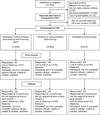A Web-based communication aid for patients with cancer: the CONNECT Study
- PMID: 23335150
- PMCID: PMC3604078
- DOI: 10.1002/cncr.27874
A Web-based communication aid for patients with cancer: the CONNECT Study
Abstract
Background: Cancer patients and their oncologists often report differing perceptions of consultation discussions and discordant expectations regarding treatment outcomes. CONNECT, a computer-based communication aid, was developed to improve communication between patients and oncologists.
Methods: CONNECT includes assessment of patient values, goals, and communication preferences; patient communication skills training; and a preconsultation physician summary report. CONNECT was tested in a 3-arm, prospective, randomized clinical trial. Prior to the initial medical oncology consultation, adult patients with advanced cancer were randomized to the following arms: 1) control; 2) CONNECT with physician summary; or 3) CONNECT without physician summary. Outcomes were assessed with postconsultation surveys.
Results: Of 743 patients randomized, 629 completed postconsultation surveys. Patients in the intervention arms (versus control) felt that the CONNECT program made treatment decisions easier to reach (P = .003) and helped them to be more satisfied with these decisions (P < .001). In addition, patients in the intervention arms reported higher levels of satisfaction with physician communication format (P = .026) and discussion regarding support services (P = .029) and quality of life concerns (P = .042). The physician summary did not impact outcomes. Patients with higher levels of education and poorer physical functioning experienced greater benefit from CONNECT.
Conclusions: This prospective randomized clinical trial demonstrates that computer-based communication skills training can positively affect patient satisfaction with communication and decision-making. Measurable patient characteristics may be used to identify subgroups most likely to benefit from an intervention such as CONNECT.
Copyright © 2013 American Cancer Society.
Conflict of interest statement
There are no financial disclosures from any of the authors.
References
-
- Chan A, Woodruff RK. Communicating with patients with advanced cancer. J Palliat Care. 1997;13(3):29–33. - PubMed
-
- McCool J, Morris J. Focus of doctor-patient communication in follow-up consultations for patients treated surgically for colorectal cancer. J Manag Med. 1999;13(2–3):169–77. - PubMed
-
- Quirt CF, Mackillop WJ, Ginsburg AD, et al. Do doctors know when their patients don't? A survey of doctor-patient communication in lung cancer. Lung Cancer. 1997;18(1):1–20. - PubMed
-
- Meropol NJ, Weinfurt KP, Burnett CB, et al. Perceptions of patients and physicians regarding phase I cancer clinical trials: implications for physician-patient communication. J Clin Oncol. 2003;21(13):2589–2596. - PubMed
-
- Cheng JD, Hitt J, Koczwara B, et al. Impact of quality of life on patient expectations regarding phase I clinical trials. J Clin Oncol. 2000;18(2):421–428. - PubMed
Publication types
MeSH terms
Grants and funding
LinkOut - more resources
Full Text Sources
Other Literature Sources
Medical


